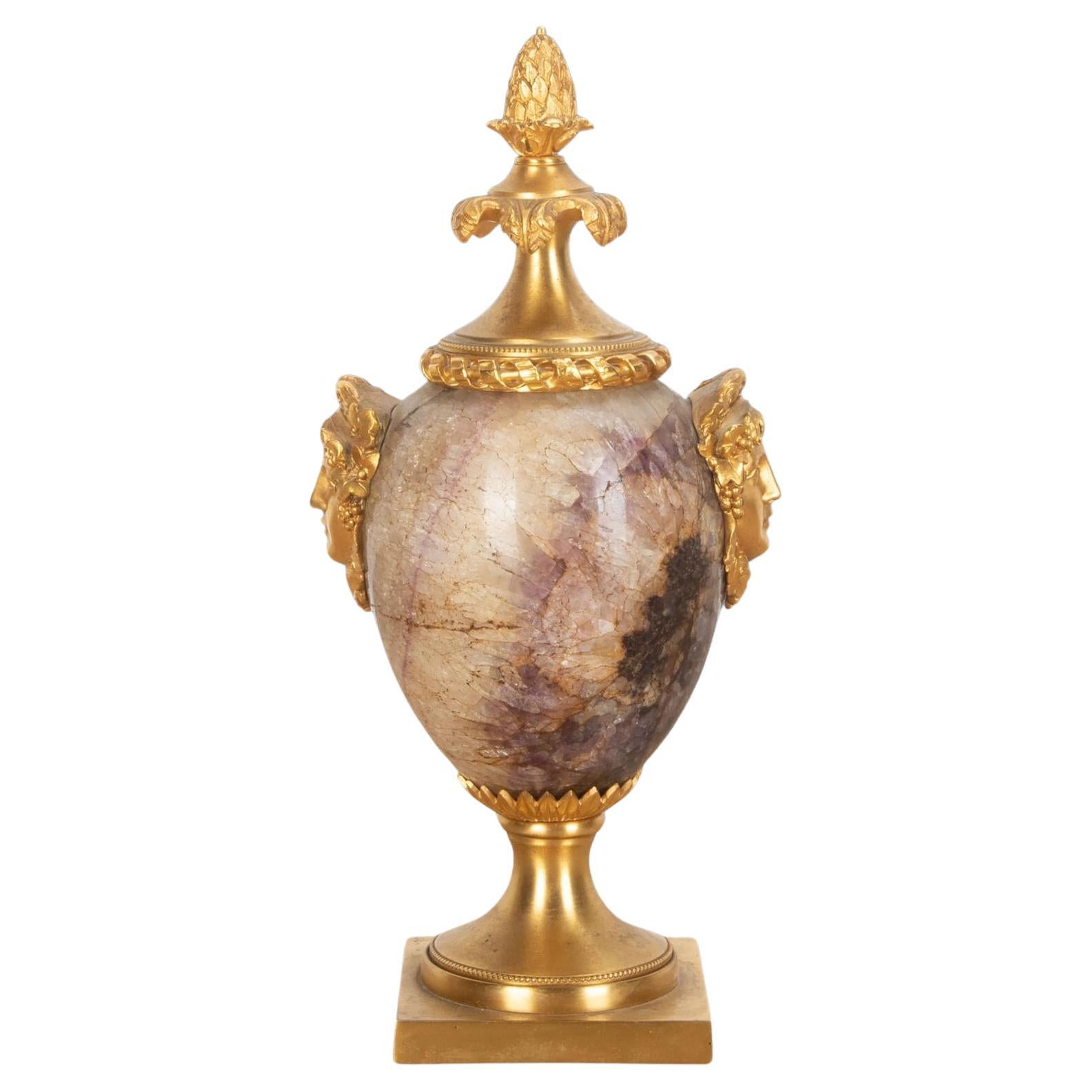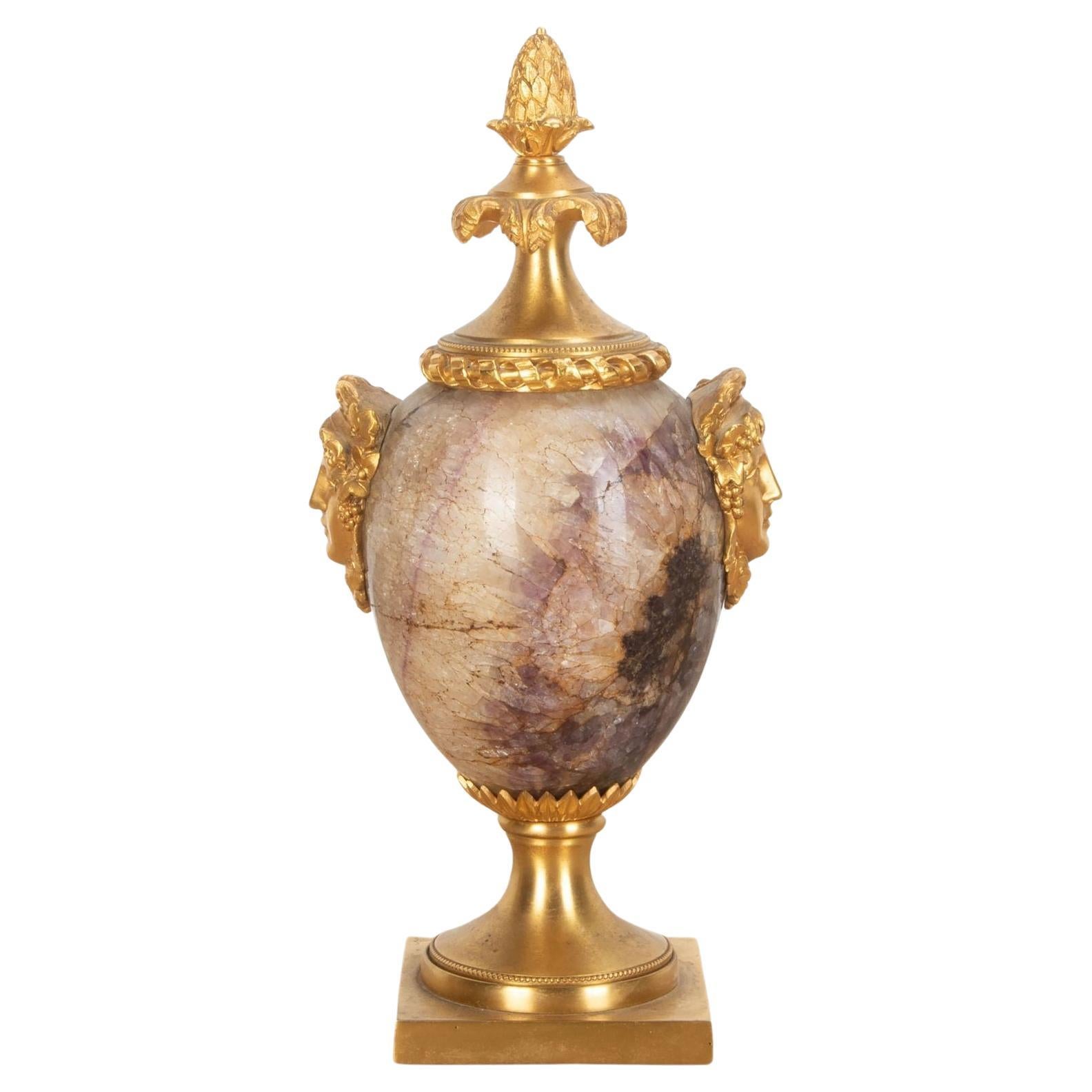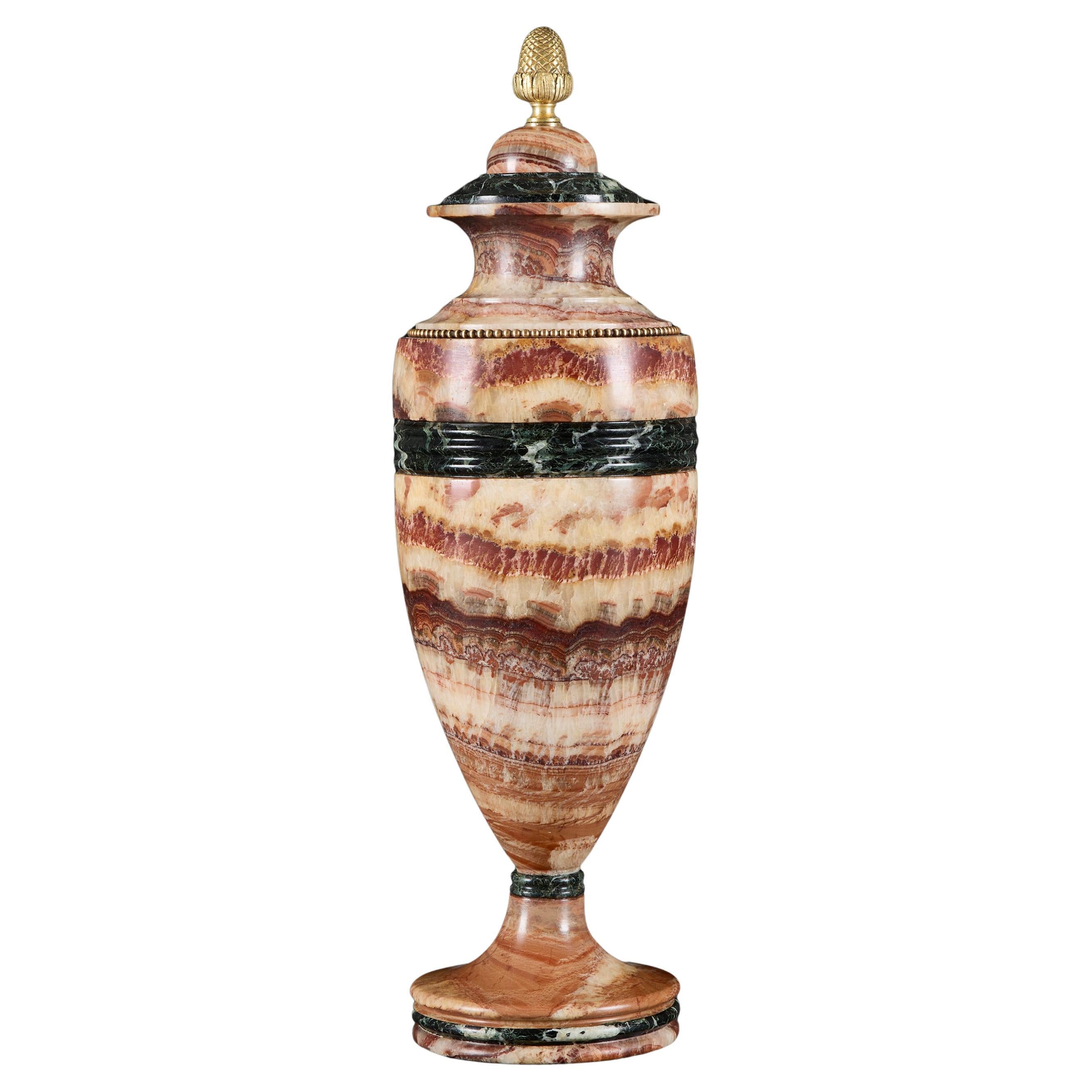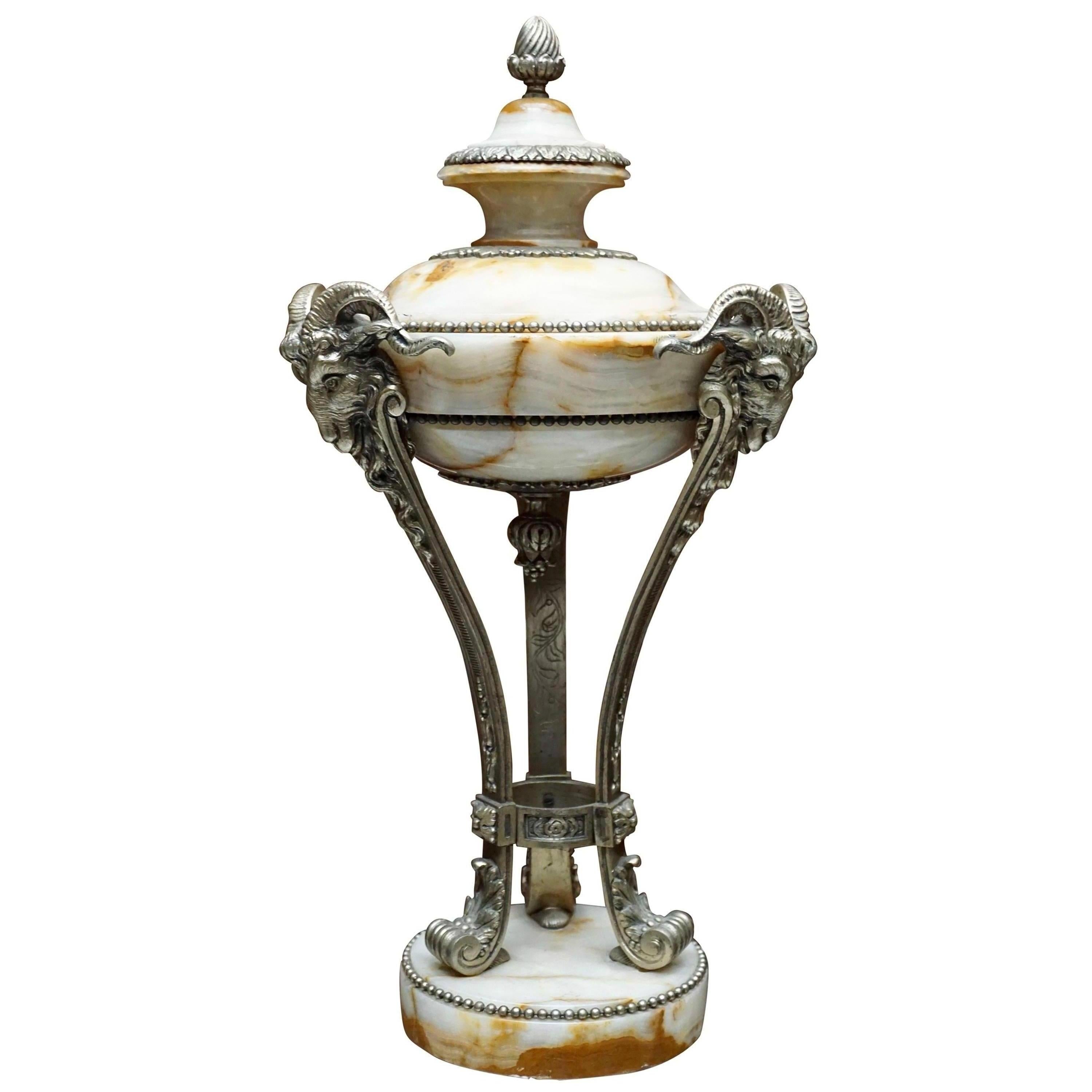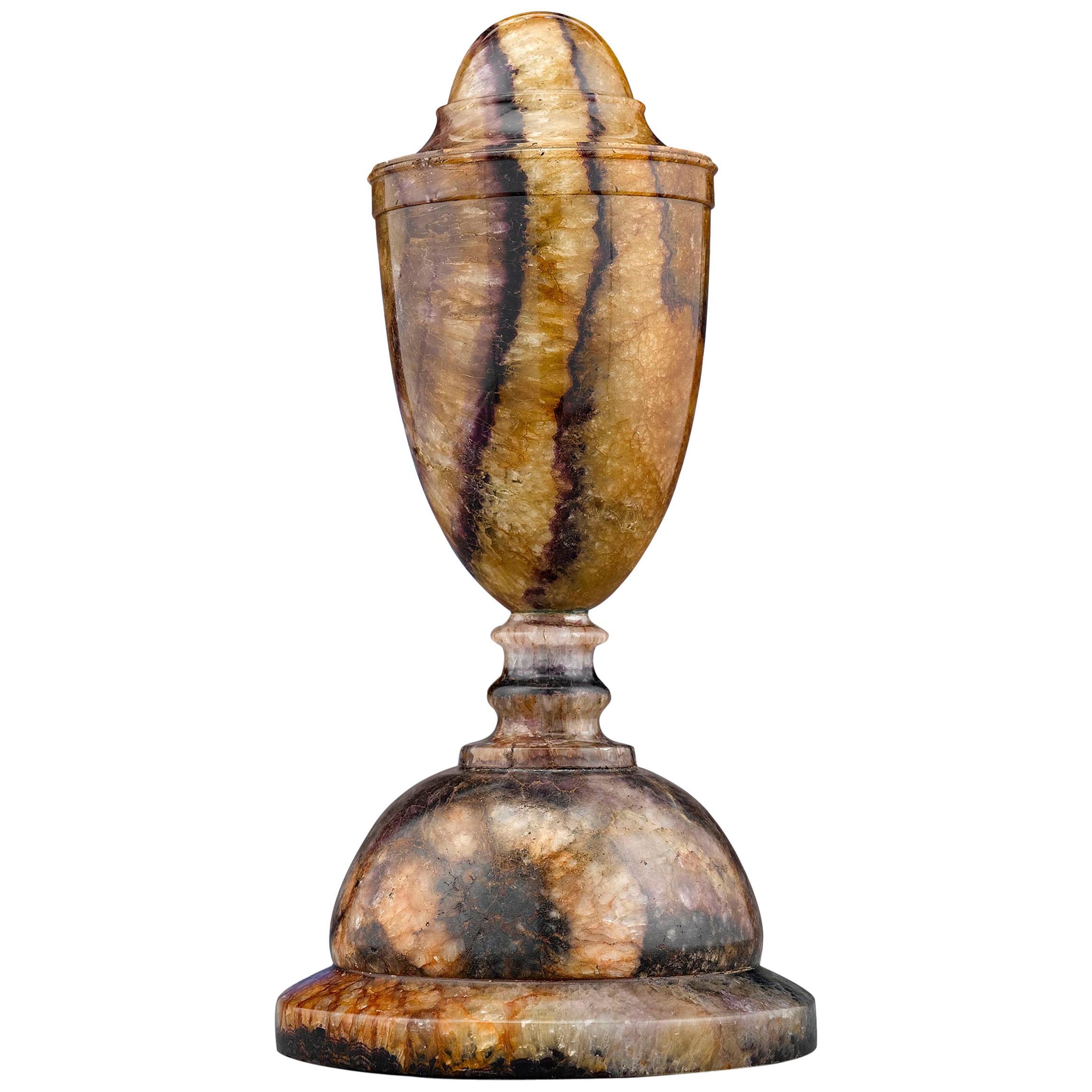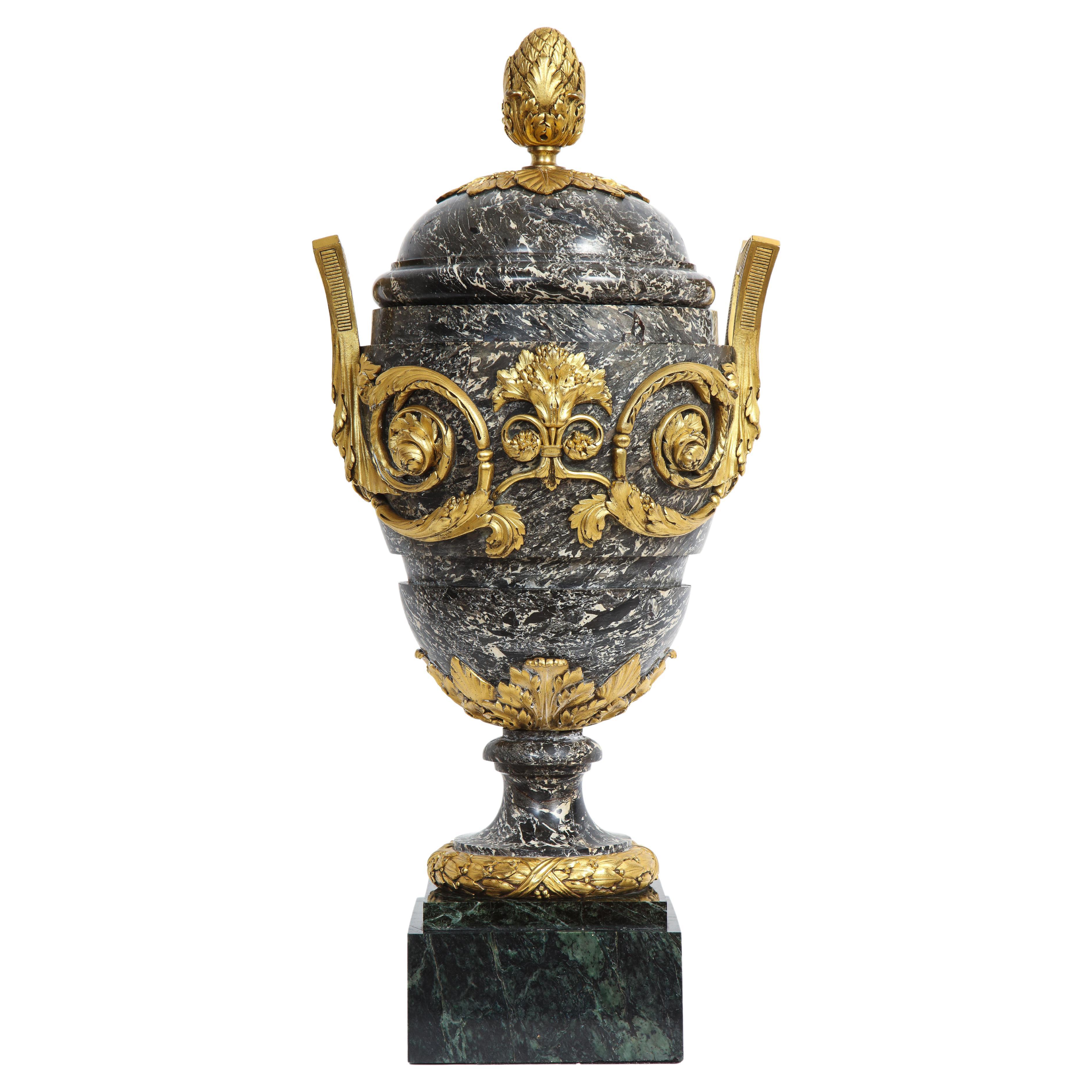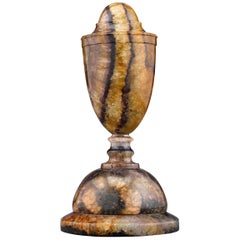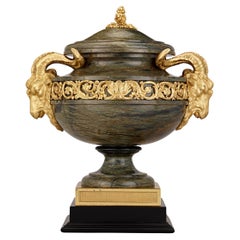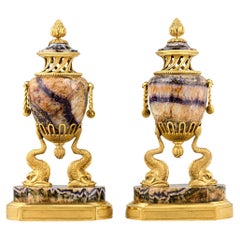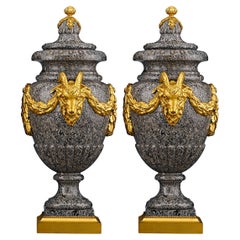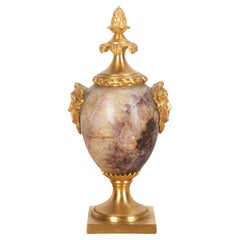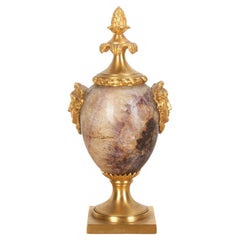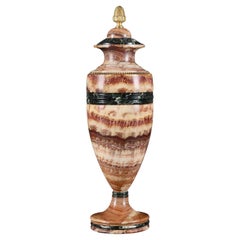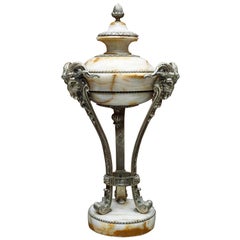Items Similar to Georgian Blue John and Silver Urn
Want more images or videos?
Request additional images or videos from the seller
1 of 5
Georgian Blue John and Silver Urn
$98,500
£74,294.45
€85,810.82
CA$138,005.29
A$153,453.96
CHF 80,335.91
MX$1,874,468.79
NOK 1,009,499.95
SEK 949,637.01
DKK 640,571.90
About the Item
This important George III blue John urn is attributed to famed Swedish architect Sir William Chambers. The solid piece is carved entirely from rare Blue John Derbyshire spar, taken from the now-extinct Blue John Cavern in Derbyshire, England. Set atop its Ashford marble plinth, the form is mounted with elaborate silver ornament, including scrolling foliage and grotesque masks.
Blue John spar is a semi-precious mineral recognized by its beautiful radiating crystalline structure, which was only mined at a site near the village of Castleton in Derbyshire. Celebrated for its unique bands of blues, purples, and violets, Blue John was in great demand during the 18th and early 19th centuries. The colorful and decorative stone was even worked into columns in some of the finest houses in Great Britain, most notably Chatsworth, home of the Duchess of Devonshire. Due to its popularity, the largest veins of Blue John had disappeared by the early 19th century, and only a small amount of the stone remains. This rare Blue John urn, therefore, represents some of the last ornamental wares created of such grand size and proportion.
The architect and designer Sir William Chambers was born in Sweden and traveled widely throughout his life. Not only did he visit China, but also studied architecture both in Paris and in Italy. Many of his drawings from this period are contained in his important 'Franco-Italian' album, currently held in the Victoria & Albert Museum. Chambers moved to London in 1755 and published his influential Treatise on Civil Architecture in 1759. Although a highly trained court architect, Chambers boasted connoisseurship of furniture design including that of silver. Chambers was highly influenced by Continental Neoclassicism, and a second visit to Paris in 1774 confirmed the French influence on his own unique blend of Neoclassicism and Palladian conventions. Today, pieces by Chambers are highly sought after and can be found in important collections worldwide, including the Victoria & Albert Museum in London.
Measures: 12 1/2" high x 5 1/2" diameter.
- Creator:Sir William Chambers (Maker)
- Dimensions:Height: 12.5 in (31.75 cm)Diameter: 5.5 in (13.97 cm)
- Style:Neoclassical (In the Style Of)
- Materials and Techniques:
- Place of Origin:
- Period:
- Date of Manufacture:18th Century
- Condition:
- Seller Location:New Orleans, LA
- Reference Number:Seller: 30-38501stDibs: LU891118736232
About the Seller
5.0
Recognized Seller
These prestigious sellers are industry leaders and represent the highest echelon for item quality and design.
Established in 1912
1stDibs seller since 2010
111 sales on 1stDibs
Typical response time: 9 hours
- ShippingRetrieving quote...Shipping from: New Orleans, LA
- Return Policy
Authenticity Guarantee
In the unlikely event there’s an issue with an item’s authenticity, contact us within 1 year for a full refund. DetailsMoney-Back Guarantee
If your item is not as described, is damaged in transit, or does not arrive, contact us within 7 days for a full refund. Details24-Hour Cancellation
You have a 24-hour grace period in which to reconsider your purchase, with no questions asked.Vetted Professional Sellers
Our world-class sellers must adhere to strict standards for service and quality, maintaining the integrity of our listings.Price-Match Guarantee
If you find that a seller listed the same item for a lower price elsewhere, we’ll match it.Trusted Global Delivery
Our best-in-class carrier network provides specialized shipping options worldwide, including custom delivery.More From This Seller
View AllBlue John Closed Urn
Located in New Orleans, LA
This beautiful ornamental urn is carved of rare Blue John Derbyshire spar, taken from the now-extinct Blue John Cavern in Derbyshire, England. Crafted in a classically-inspired shape, this closed urn evokes the elegance of the Georgian period. Since the Roman era, Blue John was used to create fine decorative wares. This intriguing stone demands a great deal of skill in its handling and was the material most favored by silversmith Matthew Boulton, especially for the creation of his stoneware vases. A soft and brittle stone, it responds very quickly to heat, and must be carefully dried in order to retain its original color. This urn is wonderful example of Blue John artistry,
circa 1810
Measures: 11 5/8" high
Discovered by the Romans over 2,000 years ago, Blue John stone...
Category
Antique 19th Century English Georgian Urns
Materials
Stone
$24,500
18th-Century Gilt Bronze & Egitto Serpentino Urn After Pierre Gouthière
Located in New Orleans, LA
This 18th-century gilt bronze & Egitto Serpentino urn is modeled after the opulent design of one of the last gilders of the Versailles Court, Pierre Gouthière. An identical urn is he...
Category
Antique 18th Century French Louis XVI Urns
Materials
Marble, Bronze, Ormolu
Pair Of Blue John And Bronze Cassolettes
Located in New Orleans, LA
Blending natural wonder and artistic prowess, this magnificent pair of cassolettes is a symphony of craftsmanship. The intricate gilt bronze decor, only made possible by the finest c...
Category
Antique Late 19th Century Jars
Materials
Stone, Bronze
$68,850 / set
Henry Dasson Egyptian Granite And Bronze Urns
By Henry Dasson
Located in New Orleans, LA
Henry Dasson used grey granite from the famed Aswan quarries in Egypt to craft this pair of rare and important urns. Aswan was the location from which ancient Egyptian builders quarried the rare granite used...
Category
Antique 19th Century French Neoclassical Urns
Materials
Granite, Bronze
$54,500 / set
Thomas Webb & Sons Cameo Two-Handled Vase by George Woodall
By George Woodall, Thomas Webb & Sons
Located in New Orleans, LA
This rare and significant cameo glass vase exemplifies the exceptional craftsmanship of George Woodall, a master artist celebrated for his outstanding skill in cameo carving. The amp...
Category
Antique 19th Century English Other Vases
Materials
Glass
Wedgwood Black Basalt Two-Handled Urn
By Wedgwood
Located in New Orleans, LA
A remarkable example of Josiah Wedgwood's legendary ceramic art, the importance and rarity of this urn vase simply cannot be overstated. Black basalt refers to the fine-grained stoneware developed by Josiah Wedgwood in the 1760s that was inspired by the hard, natural stone known as Egyptian basalt...
Category
Antique 19th Century English Urns
Materials
Ceramic, Stoneware
You May Also Like
18th Century Blue John Urn
By Mathew Bolton
Located in Shipston-On-Stour, GB
A wonderful late C18th Ormolu mounted Blue John urn, attributed to the workshop of Matthew Boulton. The acorn finial with rope twist border, above pale veining and rich purple marb...
Category
Antique 1780s English Adam Style Urns
Materials
Marble, Ormolu
18th Century Blue John Urn
Located in Gloucestershire, GB
A wonderful late 18th Century ormolu mounted Blue John urn, attributed to the workshop of Matthew Boulton.
The acorn finial with rope twist border, above pale veining and rich purple...
Category
Antique 1780s Antiquities
Materials
Ormolu
A Mid-19th Century Blue John and Marble Urn
Located in London, GB
England, circa 1850.
A mid nineteenth century large blue john urn, with Verde Antico gadrooned bands, fashioned as a classical urn with gilt bronze finial and splayed foot.
Height ...
Category
Antique 19th Century English Urns
Materials
Marble, Ormolu
A Nice Pair of Onyx and Silvered Bronze Ornamental Vases
Located in Antwerp, BE
A good pair of antique marble cassolette.
A nice pair of onyx and silvered bronze ornamental vases in the Robert Adam style.
The three feet resting on circu...
Category
Early 20th Century French Louis XVI Urns
Materials
Marble, Onyx, Metal, Bronze
$1,719 Sale Price / set
70% Off
A Monumental 18/19th C. French Ormolu Mounted Grey Marble Covered Urn w/ Handles
Located in New York, NY
A Monumental Late 1700's/Early 1800's French Ormolu Mounted Marble Covered Urn
Presenting an extraordinary Monumental 18/19th Century French Ormolu Mounted Marble Covered Urn. Crafted with meticulous precision, this exquisite urn showcases a captivating blend of materials and intricate ornamentation.
The urn features a splendid mid-toned grey uniformly patterned marble, skillfully carved into a rounded bulb. Both the lid and body of the urn gracefully mimic the contours of an egg, lending an harmonious and organic appeal to the overall design. Adorning the base of the body are carved ormolu ferns, beautifully encircling the bottom of the belly as it descends to a marble pedestal that is ringed at the bottom with an ormolu wreath resting atop a stunning cubic stepped deep-green marble plinth.
Crowning the urn is a pineapple finial, exquisitely crafted from ormolu bronze. Encircling the base of this handle, one can admire a delicate ring of foliate ormolu bronze, adding a touch of sophistication to the composition. The handles on either side of the urn are a delightful departure from the conventional, boasting ribbed, angled, and bent-square ormolu designs. This unexpected detail adds a refreshing and distinctive element to the overall aesthetic.
To further enhance its grandeur, the grey marble urn is adorned with ornate and delicate foliate ormolu bronze scrolls. These intricate scrolls gracefully meander along the belly of the urn, lending a sense of opulence and refinement to the piece.
In terms of size, this Monumental 18/19th Century French Ormolu Mounted Marble Covered Urn commands attention with its substantial proportions. Standing tall and proud, its dimensions convey magnificence and presence, truly befitting its status as a significant antique artifact...
Category
Antique Late 18th Century Urns
Materials
Marble, Ormolu
French 19th Century Louis XVI St. Marble and Ormolu Lidded Urn
Located in West Palm Beach, FL
A stunning and impressive French 19th century Louis XVI st. marble and ormolu lidded urn. The urn is raised on a circular base decorated with acanthus leaves and an ormolu band above...
Category
Antique 19th Century French Louis XVI Urns
Materials
Marble, Ormolu
More Ways To Browse
French Neoclassical Urns
Antique Silver Urn
Blue John Antique
Black Urn Vases
Marble Carved Urn
Neoclassical Marble Urn
18th Century French Urns
Antique Stone Vessel
Neoclassical Black Vase
French Blue Urn
Antique Chinese Urns
Black Stone Columns
Italian Marble Urn
Antique Stone Plinths
Early Georgian China
Solid Silver Vase
Small Decorative Urns
Continental Vases
